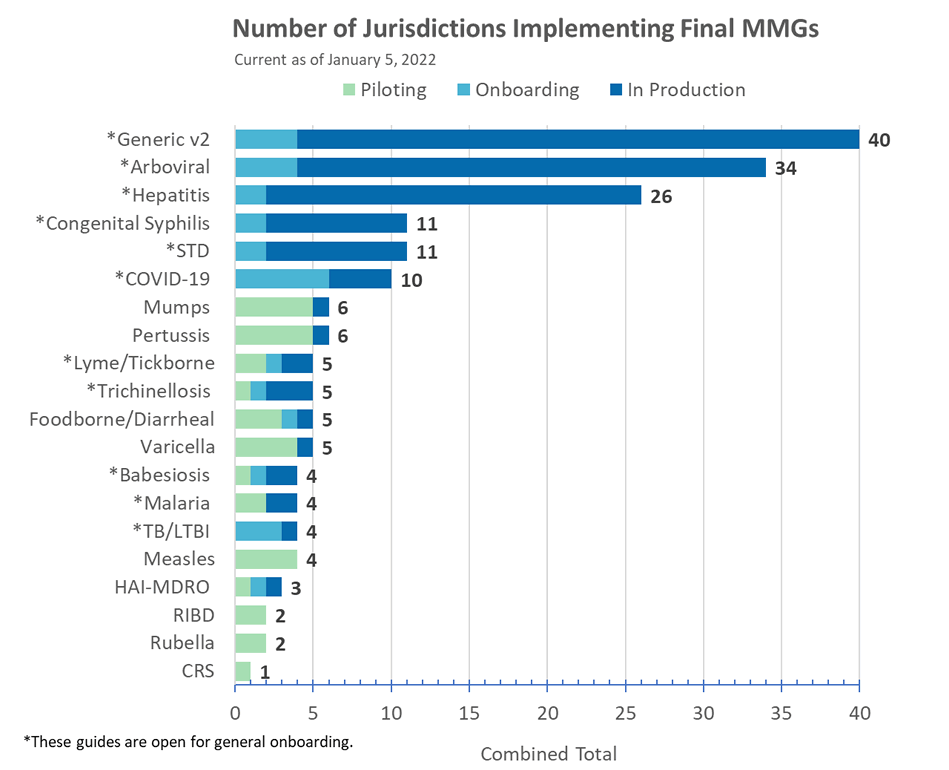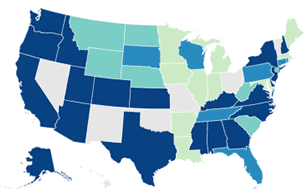January 2022
January 18, 2022, 3:00 – 4:00 ET: eSHARE webinar: “What States Need to Know for 2022”
June 19–23, 2022: Council of State and Territorial Epidemiologists (CSTE) Annual Conference, Louisville, Kentucky. Learn more

NNDSS modernizes processing and publication of weekly and annual data
In December 2021, the National Notifiable Diseases Surveillance System (NNDSS) implemented improvements to processing and publication of weekly and annual case count tables for over 120 national notifiable diseases and conditions.
CDC receives NNDSS data from state and territorial health departments in multiple formats and combines these data streams into unified datasets for use by CDC programs.
For over three decades, the NNDSS team used statistical analysis software and spreadsheets to create and manage the weekly and annual datasets. The old process required the team to manually run data processing programs at several points in the data pipeline. Manual steps made the data pipeline cumbersome, time consuming, and vulnerable to human error.
The NNDSS team has now fully automated processing and publication of weekly and annual tables for all NNDSS conditions. The improvements:
- speed up processing of all NNDSS data sources,
- reduce the potential for data processing errors,
- empower the NNDSS team to quickly identify and troubleshoot issues, and
- leverage new features that provide jurisdictions more ability to see and interact with their data.
These improvements to NNDSS data processing and publication support CDC’s data modernization goals to improve timeliness and quality of data, better coordinate data activities and systems, and reduce burden on data partners.
The next eSHARE webinar, “What States Need to Know for 2022,” is scheduled for January 18, 2022, 3:00pm-4:00pm ET.
To join a webinar, please see your Outlook invitation or contact the CDC Electronic Data Exchange mailbox at edx@cdc.gov for login information with the subject line “eSHARE invitation.”
NNDSS publishes weekly case counts through CDC WONDER and data.cdc.gov.
To ensure updates are included in the weekly publication, case notifications should be received by 6:00 PM ET on Tuesdays.
Arboviral Message Mapping Guide (MMG)
CDC has posted an updated Arboviral Disease Reporting Surveillance Guide to the NNDSS website under current “Artifacts.”
COVID-19 Message Mapping Guide
- The PHIN Vocabulary Access and Distribution System COVID-19 Case Notification View version 11 is now available. It includes an additional value for both Vaccine Type (NND) and Manufacturers of vaccines (MVX).
Congratulations to the following jurisdictions in production as of January 5, 2022!
- Florida for COVID Lite
- New Jersey for COVID Lite
If you are interested in joining a cohort or onboarding an MMG, please email the CDC Electronic Data Exchange mailbox at edx@cdc.gov.
Starting January 2022: Improvements to the message mapping guide onboarding process
NNDSS is improving the process of onboarding new MMGs based on feedback from jurisdictions and CDC programs. These improvements will go into effect in January 2022.
Onboarding is the process used to transition jurisdictions sending case notifications to CDC in older (legacy) formats to the new HL7 format. It helps CDC programs ensure that the data are based on the final NNDSS HL7 MMG requirements and that they can be confident in the data they receive.
Why is CDC updating the MMG onboarding process?
The refined data-driven process is transparent and standardized. It clearly defines:
- roles of jurisdictions and CDC programs in the onboarding process;
- shared goals, expectations, and timelines; and
- phases of onboarding.

In addition to being responsive to the needs of jurisdiction and program partners, the streamlined process will allow NNDSS to increase the number of jurisdictions and MMGs onboarded.
What are the changes to the process?
- Engages CDC programs during the jurisdiction’s pre-onboarding gap analysis to provide guidance prior to jurisdiction system updates.
- Adds Association of Public Health Laboratories (APHL) review, validation, and feedback of test messages and artifacts to ensure that any message formatting issues are found and resolved before data are submitted to CDC.
- Sets clear expectations and defines timelines during the kick-off call to minimize delays and move jurisdictions and CDC programs more quickly through the process.
- Provides specific case scenarios to ensure correct handling of complicated or rare issues.
- Increases the number of limited production messages to identify content and mapping errors in one step and eliminates line-level review of year-to-date files, allowing the jurisdiction to be moved to production earlier in the process.
If you have questions about these updates to the MMG onboarding process, email edx@cdc.gov with subject line “Onboarding Process.” We are also working to update the CDC website to reflect the new process in early 2022.







